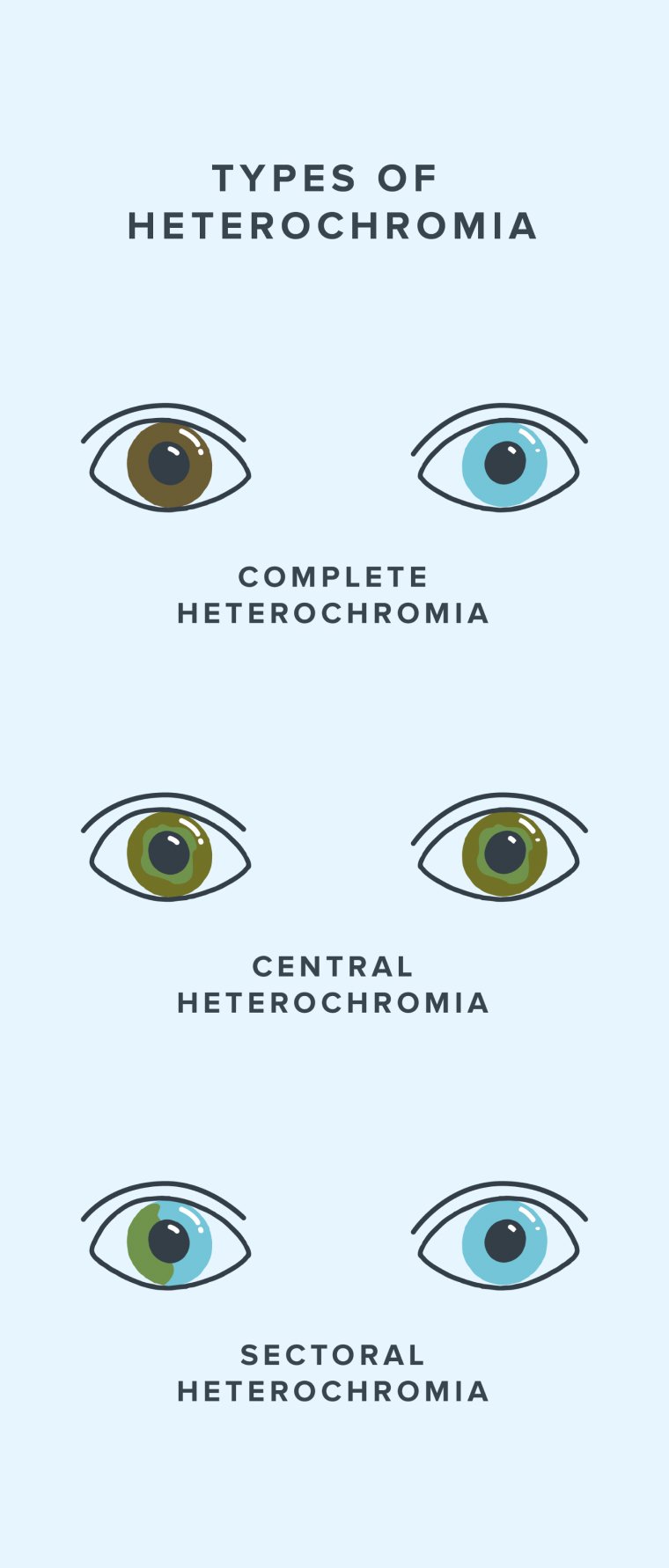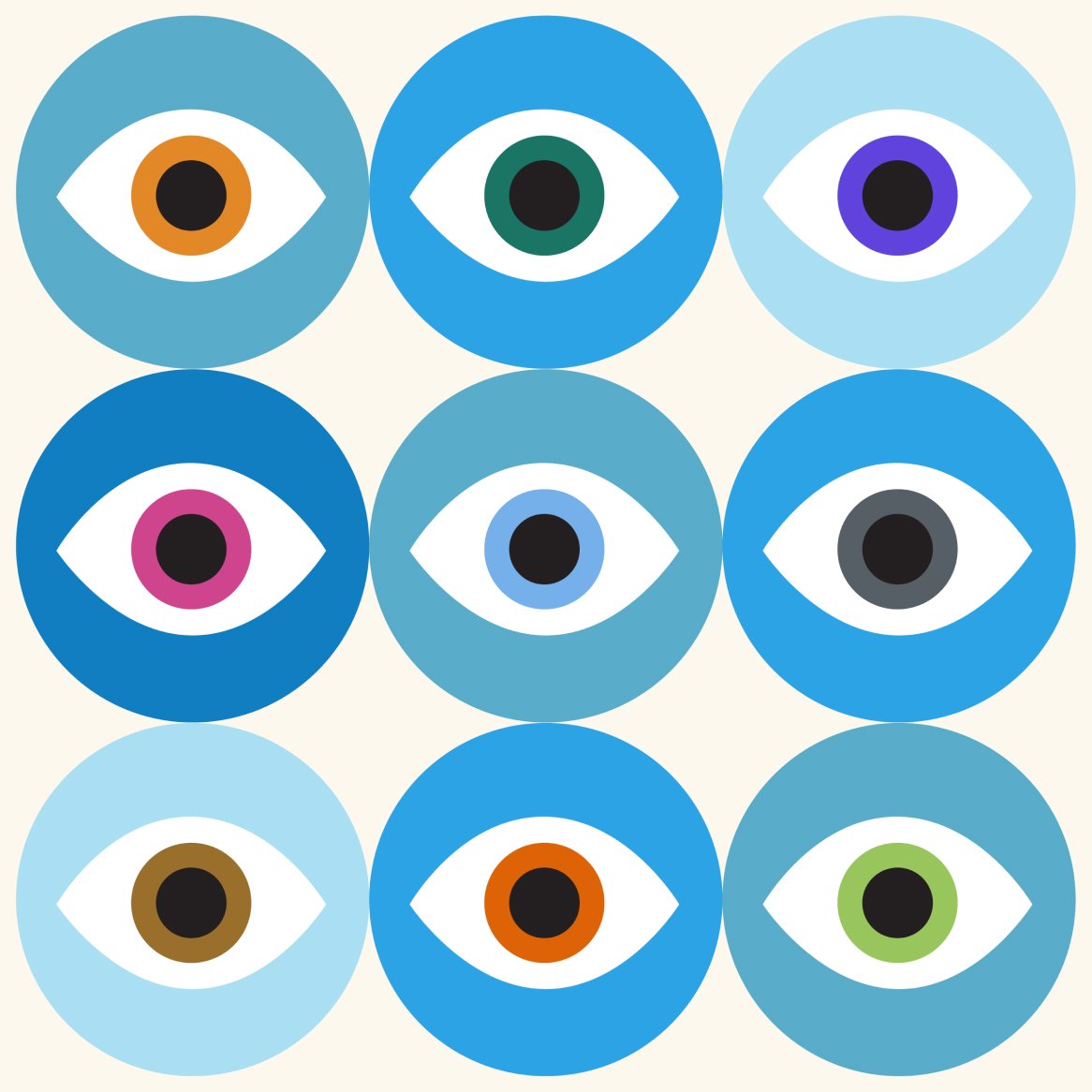“Heterochromia” means a difference in color, from the Greek words “hetero” (different) and “chroma” (color). Usually, when people talk about heterochromia, they’re referring to when a person has different-colored eyes. But technically, this term can apply to other things affected by pigmentation (coloring) too, such as hair and skin. When you’re talking about the eyes, the more accurate term is “heterochromia iridum” or “heterochromia iridis.”
And here’s something else you might not know: There are actually different kinds of heterochromia, and the way it looks can vary widely from person to person. It’s a unique and interesting condition—that’s why we’ve gathered up everything you might want to know about heterochromatic eyes and turned it into one helpful article. Let’s dive in.
Types of Heterochromia
Heterochromia doesn’t always mean having two different colored eyes. There are actually three different kinds of heterochromia, which are classified by the amount of the iris (the colored part of the eye around the pupil) that’s affected.
Complete Heterochromia
Complete heterochromia is the type that most people think of when they think about the condition. A person with complete heterochromia has eyes that are completely different colors (hence the name). For instance, one eye might be blue, and the other might be green.
Central Heterochromia
Central heterochromia usually affects both eyes. With this type of heterochromia, the iris is one color near the center of the eye around the pupil, and then it changes to another color near the outer edge.
With central heterochromia, you can think of the iris as a target—the pupil is the bullseye with two rings of color around it. For example, the iris might have green around the pupil that shifts into brown towards the edge.
Sectoral Heterochromia
Sectoral heterochromia may affect one or both eyes. This type is also called partial heterochromia because it only affects part of the iris. An eye with sectoral heterochromia will have two different eye colors in the same iris. It’s so named because a section of the iris will have a secondary color.
With sectoral heterochromia, you can think of the iris as a pie—one slice of the pie will be a different color, and that slice can be any size (from a humble “sliver” to a hefty slice that makes up two-thirds of the pie).
How Rare Is Heterochromia?
Heterochromia is a rare condition in humans, affecting less than 1% of the U.S. population. It’s more common in other species of the animal kingdom, though—especially in some breeds of dogs, cats, and horses.
What Causes Heterochromia?
Most of the time, heterochromia is present at birth, but sometimes it can develop later in life. In the majority of cases, an individual with heterochromia experiences no health issues due to this condition—it only affects eye color.
Let’s take a closer look at what causes someone to have these types of eye color variations.
Is Heterochromia Genetic?
Yes, genetics can cause heterochromia. When heterochromia is present at birth, it’s referred to as congenital heterochromia.
Your genes influence the melanin levels in your irises—the pigmentation that gives your irises their color. But it’s typically a genetic mutation that causes heterochromia, which means it’s more like a surprise change that happens during your genes’ development than a trait that you inherit from your parents.
If a child does inherit heterochromia, it may indicate the child inherited an underlying condition that causes heterochromia—not the heterochromia itself.
Underlying Conditions That May Cause Congenital Heterochromia
Although it’s rare, sometimes congenital heterochromia is caused by a medical condition. Some of these conditions include:
- Waardenburg syndrome
- Horner’s syndrome
- Sturge-Weber syndrome
- Hirschsprung disease
- Piebaldism
- Bloch-Sulzberger syndrome
- Bourneville disease (tuberous sclerosis)
- Von Recklinghausen disease
- Parry-Romberg syndrome
But remember: The majority of the time, heterochromia affects nothing but eye color and isn’t cause for concern.
Acquired Heterochromia Causes
In some cases, heterochromia might not develop until later in life, which is called acquired heterochromia. When this happens, it’s typically caused by an injury to the eye, topical drugs used for eye conditions such as glaucoma, or other medical conditions, such as diabetes, that can affect the eyes.
If you notice you have developed heterochromia and it wasn’t present before, you can contact your eye doctor to help determine the cause.
Celebrate Your Eye Color(s)
There’s certainly something to be said about the beauty and uniqueness found in eyes. Whether you’re the umpteenth generation hosting the same baby blue eyes, have one of the rarest eye colors in the world, or are among the few who can say they have two different-colored eyes, your eyes are a part of what makes you…you.
So celebrate those peepers. (And if your way of doing that is with new stylish glasses or contacts, we certainly won’t blame you.)







